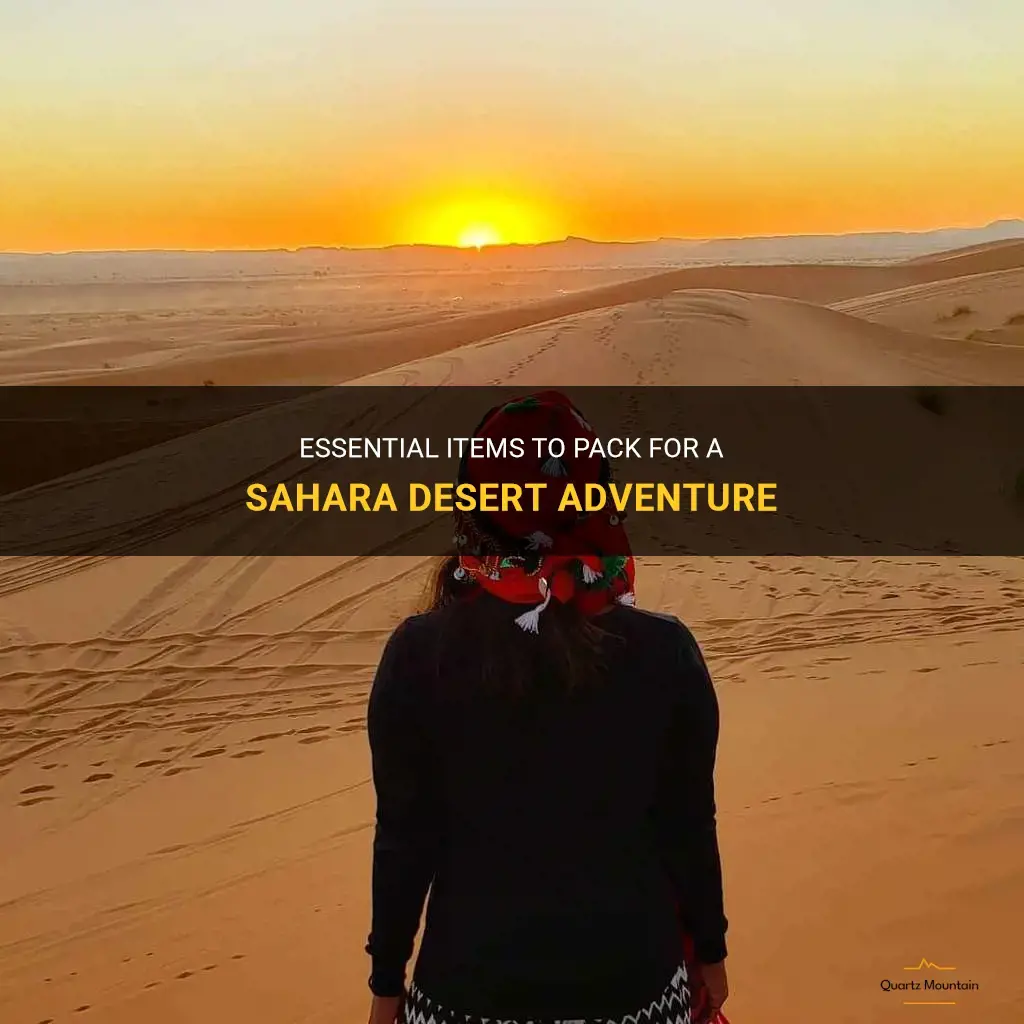
The vast and stunning Sahara Desert is a bucket-list destination for many adventurers around the world. Whether you are planning a camel trek through the dunes or a camping adventure under the starry desert sky, the Sahara offers an unparalleled experience. However, venturing into this harsh and unforgiving landscape requires careful preparation, especially when it comes to packing the essential items that will ensure your safety and comfort. In this guide, we will explore the must-have items for a Sahara Desert adventure, helping you make the most of your once-in-a-lifetime trip to this awe-inspiring natural wonder.
| Characteristics | Values |
|---|---|
| Clothing | Loose, light-colored and breathable |
| Footwear | Sturdy, closed-toe shoes or boots |
| Headgear | Wide-brimmed hat or scarf |
| Eyewear | Sunglasses with UV protection |
| Sunscreen | High SPF and water-resistant formula |
| Water | Sufficient supply for hydration |
| Food | non-perishable, high-energy snacks |
| Medications | First aid kit and necessary prescription |
| Navigation | Compass and detailed maps |
| Lighting | Flashlights or headlamps |
| Shelter | Lightweight tent or sleeping bag |
| Protection | Insect repellent and mosquito net |
| Communication | Satellite phone or mobile with signal |
| Entertainment | Books, games or portable music devices |
| Cash | Sufficient money for emergencies or purchases |
| Identification | Passport, visa and travel documents |
What You'll Learn
- What are the essential items to pack for a trip to the Sahara Desert?
- Are there any specific type of clothing or footwear that would be recommended for the desert climate?
- Are there any specific toiletries or personal care items that should be included in a desert packing list?
- What types of equipment or gear should be packed for activities such as hiking or camping in the Sahara Desert?
- Are there any precautionary items, such as first aid kits or emergency supplies, that should be included in a desert packing list?

What are the essential items to pack for a trip to the Sahara Desert?
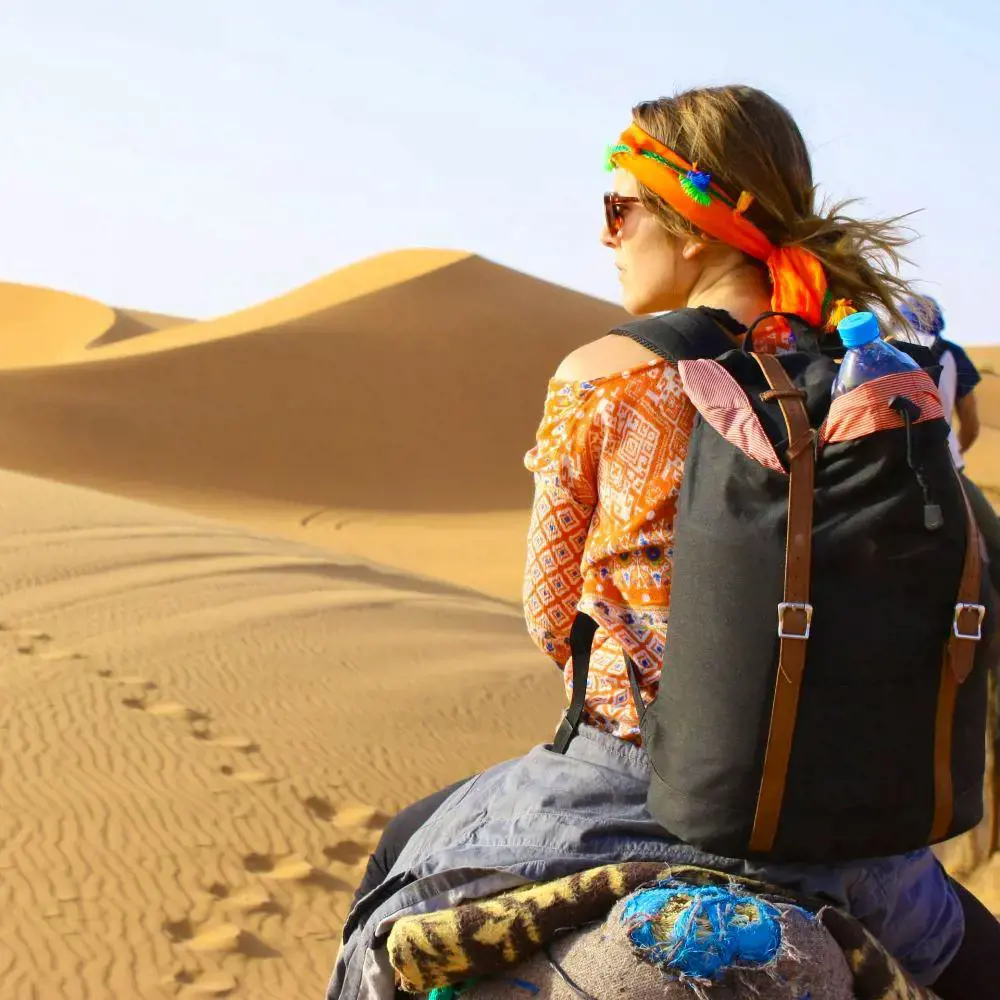
The Sahara Desert, located in North Africa, is one of the most extreme and challenging environments on Earth. Planning a trip to the Sahara requires careful preparation and packing the right essentials to ensure a safe and enjoyable journey. Here are some essential items you should consider bringing with you when venturing into this vast and unforgiving desert.
- Sun protection. The Sahara is known for its scorching heat and intense sun. To protect yourself from sunburn and heatstroke, pack a wide-brimmed hat, sunglasses with UV protection, and a high SPF sunscreen. Wearing lightweight, loose-fitting clothing and covering exposed skin can also provide additional protection.
- Water and hydration. Staying hydrated is crucial in the desert, where temperatures can soar to extreme highs. Carry ample amounts of water and drink frequently throughout the day to avoid dehydration. Consider bringing a hydration pack or water bottles with built-in filters to ensure a continuous supply of clean water.
- Navigation tools. Navigating the vast expanse of the Sahara can be challenging, especially if you're off the beaten path. Carry a reliable compass and a detailed map of the area or use a GPS device to help you navigate. Familiarize yourself with the terrain and landmarks before embarking on your journey.
- Shelter and bedding. While camping in the Sahara, having a sturdy tent or tarp is essential to protect yourself from wind, sandstorms, and potential wildlife encounters. Bring a sleeping bag or a lightweight, compact sleeping mat to provide comfort and insulation against the desert floor.
- Cooking equipment and food. As food options may be limited in the desert, it's advisable to bring your own cooking equipment and non-perishable food. Pack a lightweight camping stove, cooking utensils, and nutritious, high-energy meals that are easy to prepare. Carry enough food to sustain yourself for the duration of your trip, and consider packing some extra in case of emergencies.
- First aid kit. It's crucial to have a comprehensive first aid kit when traveling through the Sahara. Include items such as bandages, antiseptic ointment, painkillers, insect repellent, and any necessary medications you regularly take. Familiarize yourself with basic first aid techniques before your trip.
- Communication devices. While the desert may have limited or no cellular network coverage, it's essential to have a reliable means of communication with the outside world in case of emergencies. Consider bringing a satellite phone, a two-way radio, or a personal locator beacon (PLB) to signal for help if needed.
- Personal hygiene items. The desert environment can be harsh on your skin and body. Pack toiletries such as travel-sized soap, shampoo, toothpaste, and a brush or comb. Having hand sanitizer and wet wipes is essential for maintaining hygiene when water is scarce.
- Protection against insects and wildlife. Insects, scorpions, and snakes are common in the Sahara. Pack insect repellent, a mosquito net for sleeping, and consider wearing long-sleeved shirts, pants, and closed-toe shoes to minimize exposure.
- Emergency provisions. Always pack extra supplies in case of unforeseen circumstances or delays. These may include extra food, water, clothing layers, emergency blankets, a flashlight, extra batteries, and a multipurpose tool.
Remember to check the local weather and climate conditions before your trip and adjust your packing accordingly. The Sahara Desert is a beautiful yet challenging place, and proper preparation and packing will ensure a safer and more enjoyable experience.
A Complete Guide to Packing for Your Gatlinburg Adventure in April
You may want to see also

Are there any specific type of clothing or footwear that would be recommended for the desert climate?
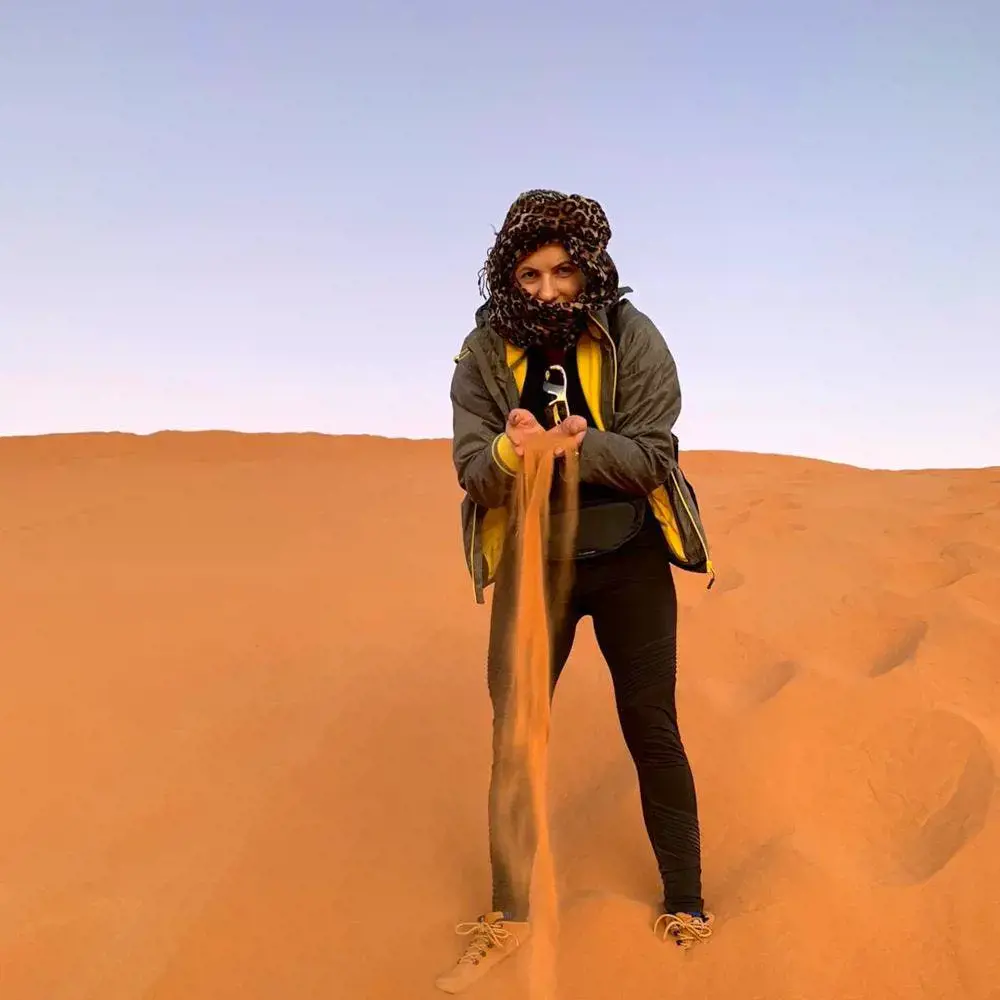
The desert climate is known for its extreme temperatures and arid conditions, which can pose unique challenges when it comes to clothing and footwear choices. In order to stay comfortable and protected in the desert, it is important to consider a few key factors when selecting your attire.
One of the most important considerations when it comes to desert clothing is the heat. Temperatures in the desert can soar well above 100 degrees Fahrenheit during the day, so it is crucial to choose lightweight and breathable fabrics that can help regulate your body temperature. Natural fibers such as cotton, linen, and silk are excellent choices, as they allow air to circulate and wick away moisture from the body. These fabrics also have the added advantage of being lightweight, which can help reduce heat retention and prevent overheating.
In addition to choosing the right fabrics, it is also important to consider the style and fit of your clothing. Loose-fitting garments are generally recommended for desert environments, as they allow for maximum airflow and ventilation. Opting for long sleeves and pants can also provide protection from the harsh sun, preventing sunburns and minimizing the risk of overheating. Some desert dwellers also prefer to wear loose-fitting, lightweight robes such as the traditional Bedouin attire, which can provide additional protection from the sun while allowing for maximum airflow.
When it comes to footwear, it is crucial to choose a pair that can withstand the harsh and unforgiving terrain of the desert. Desert landscapes often feature rocky and uneven surfaces, so it is important to select a pair of shoes that offer good grip and traction. Sturdy hiking boots or trail running shoes are excellent choices, as they provide ankle support and are designed to withstand rugged terrains. It is also important to choose footwear that is breathable and lightweight, as this can help prevent your feet from becoming overheated and sweaty.
In addition to choosing the right clothing and footwear, it is also important to take other precautions to stay safe in the desert. Drinking plenty of water and wearing a wide-brimmed hat can help prevent dehydration and protect you from the sun's rays. Applying sunscreen regularly and wearing sunglasses can also provide added protection from the harsh desert sun.
Overall, when it comes to clothing and footwear for the desert climate, it is important to prioritize comfort, breathability, and protection. By choosing the right fabrics, styles, and fit, you can stay cool and comfortable in even the most extreme desert temperatures. So, whether you are planning a desert hike, a camping trip, or simply want to explore the beauty of a desert landscape, be sure to consider these recommendations for your attire.
Essential Items to Pack for Bariatric Surgery in Mexico
You may want to see also

Are there any specific toiletries or personal care items that should be included in a desert packing list?
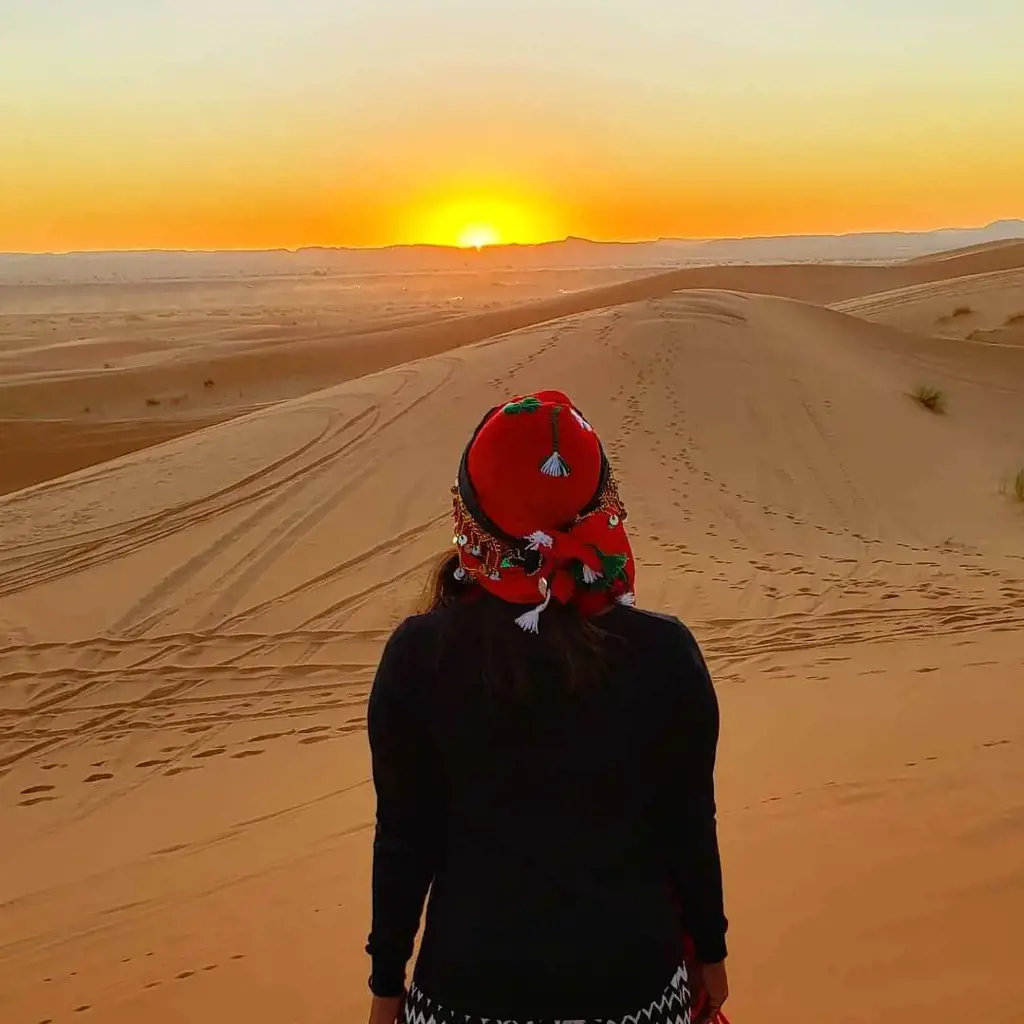
When packing for a trip to the desert, it's important to consider the unique challenges and conditions that you'll encounter. The desert environment can be harsh, with extreme temperatures, dry air, and intense sun exposure. To ensure your comfort and well-being during your desert adventure, it's crucial to include specific toiletries and personal care items in your packing list.
One of the most important items to include in your desert packing list is sunscreen. The sun in the desert can be exceptionally intense, and it's important to protect your skin from harmful UV rays. Choose a broad-spectrum sunscreen with a high SPF and apply it liberally throughout the day, paying special attention to areas that are often overlooked, such as the ears, neck, and tops of the feet.
Another essential item for your desert adventure is lip balm. The dry desert air can easily lead to chapped and cracked lips, so be sure to pack a moisturizing lip balm with SPF protection. Apply it regularly to keep your lips hydrated and protected from the harsh desert conditions.
In addition to sunscreen and lip balm, it's important to include moisturizer in your desert packing list. The dry air in the desert can quickly dehydrate your skin, leading to dryness and discomfort. Choose a lightweight, oil-free moisturizer that is suitable for your skin type. Apply it to your face and body daily to keep your skin hydrated and prevent discomfort.
Another item to consider is a hat or a scarf to protect your head and face from the intense desert sun. Choose a wide-brimmed hat or a scarf made of breathable fabric to shield your face and neck from the sun's rays. This will not only help prevent sunburn but also provide some relief from the heat.
When packing for the desert, it's also important to bring toiletries that can help you stay fresh and clean. Include travel-sized bottles of shampoo, conditioner, and body wash in your packing list. Opt for hydrating formulas that can help counteract the dryness caused by the desert environment. Additionally, pack a small towel or washcloth to use for bathing or wiping off sweat.
To combat dehydration, be sure to include a reusable water bottle in your packing list. Staying hydrated is crucial in the desert, as the dry air and high temperatures can lead to excessive sweating and fluid loss. Fill your water bottle regularly and drink plenty of fluids throughout the day to stay hydrated and prevent heat-related illnesses.
Lastly, don't forget to include a basic first aid kit in your desert packing list. This should include essentials such as band-aids, antiseptic wipes, and any necessary medication. It's always better to be prepared for any minor injuries or illnesses that may occur during your desert adventure.
In conclusion, when packing for a trip to the desert, be sure to include specific toiletries and personal care items to ensure your comfort and well-being. Sunscreen, lip balm, moisturizer, a hat or scarf for sun protection, toiletries for staying clean, a water bottle for hydration, and a basic first aid kit are all essential items to include in your desert packing list. By being prepared and taking care of your personal needs, you can fully enjoy your desert adventure while staying safe and comfortable.
Essential Items to Pack for Your Trip to Kansas
You may want to see also

What types of equipment or gear should be packed for activities such as hiking or camping in the Sahara Desert?
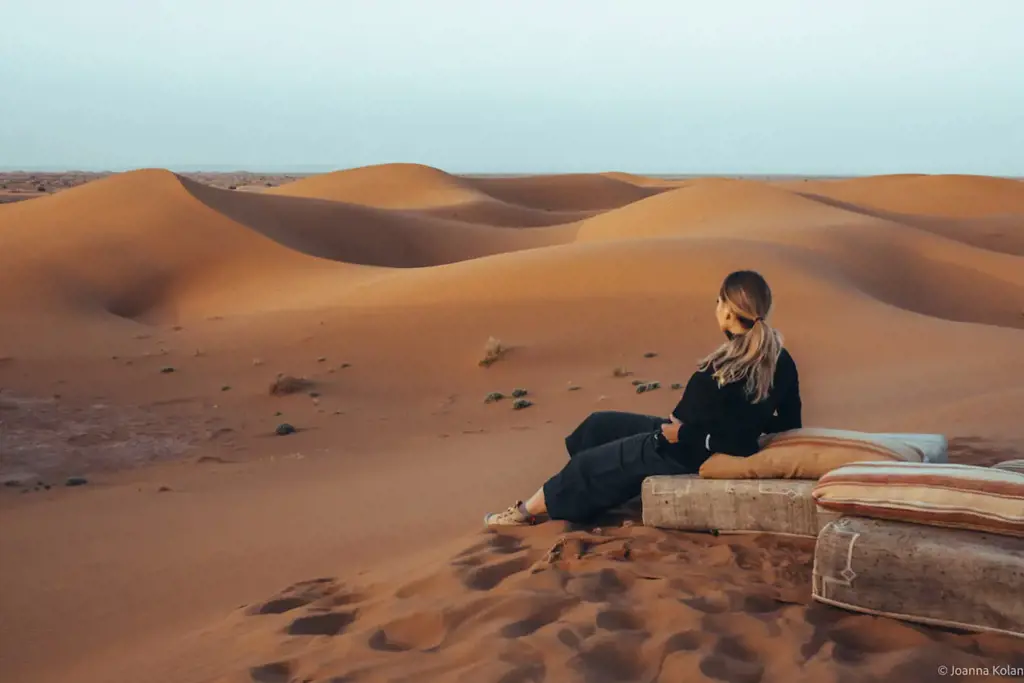
When planning a trip to the Sahara Desert, it is essential to have the right equipment and gear to ensure your safety and comfort. The extreme heat, arid climate, and vast desert landscape require specific items to make your hiking or camping experience memorable. Here are a few essential pieces of equipment to consider packing for your Sahara adventure:
- Proper Clothing: When it comes to clothing, it is crucial to opt for lightweight, loose-fitting, and breathable clothes to help combat the scorching desert heat. Loose-fitting long sleeve shirts and pants made from moisture-wicking materials provide protection from the sun while allowing for air circulation. It is also advisable to wear a hat or scarf to shield your face and neck from the intense sun rays.
- Footwear: The desert's terrain can be challenging and abrasive, so it is essential to have sturdy and comfortable footwear. Hiking boots or trail shoes with good ankle support and a rugged sole are ideal for traversing the sandy dunes. Make sure your footwear is well broken-in before embarking on your desert adventure to avoid blisters and discomfort.
- Sun Protection: The Sahara Desert is known for its relentless sun, so it is crucial to protect yourself from harmful ultraviolet (UV) rays. Sunscreen with a high SPF rating should be applied liberally to exposed skin, including your face, arms, and legs. Additionally, sunglasses with UV protection and a wide-brimmed hat will help shield your eyes and face from direct sunlight.
- Water and Hydration: Staying hydrated is a top priority while exploring the desert. It is recommended to carry a sufficient supply of water to prevent dehydration. A hydration pack or water storage system, such as a camelback, can be useful for convenient access to water while on the move. It is also advisable to pack electrolyte-replenishing drinks to replace essential minerals lost through perspiration.
- Navigation Tools: The vastness of the Sahara Desert makes it easy to get disoriented. Carrying a reliable map or GPS device is vital to help navigate your way through the dunes. Make sure you have a compass or GPS with a reliable battery life, as the desert's extreme temperatures can drain battery power quickly.
- Shelter: Whether you plan to camp overnight or not, having a lightweight and compact shelter is essential for protection against the elements. A sturdy tent or a lightweight hammock with a mosquito net will provide a comfortable place to rest and protect you from potential sandstorms or biting insects during the night.
- First Aid Kit: Accidents and injuries can happen anywhere, so it is essential to have a well-stocked first aid kit on hand. Include items such as bandages, antiseptic wipes, pain medication, insect repellent, and any personal medications you may need. It is advisable to familiarize yourself with basic first aid techniques before embarking on your trip.
- Food and Cooking Equipment: Pack lightweight, non-perishable food items that require minimal preparation. Energy bars, dehydrated meals, and dried fruits are excellent options for sustenance in the desert. A portable camping stove and cooking utensils can come in handy if you plan to cook meals during your trip.
- Lighting: The nights in the Sahara can be as stunning as the days. Carrying a reliable headlamp or flashlight will provide you with adequate illumination during nighttime walks or while setting up camp. Don't forget to pack extra batteries to ensure long-lasting light.
- Personal Essentials: In addition to the essential gear, it is essential to pack personal items such as toiletries, a small towel, hand sanitizer, and a water purification system. The Sahara Desert is known for its minimal water sources, and having a reliable purification system will allow you to sanitize water you may come across during your adventure.
Before embarking on any desert journey, it is crucial to conduct thorough research, consult experienced guides, and ensure you are physically prepared. The harsh conditions of the Sahara Desert can be unforgiving, so it is essential to have the right equipment and gear to make your experience safer and more enjoyable.
Essential Items to Pack for a Visit to Kalahari Water Park
You may want to see also

Are there any precautionary items, such as first aid kits or emergency supplies, that should be included in a desert packing list?
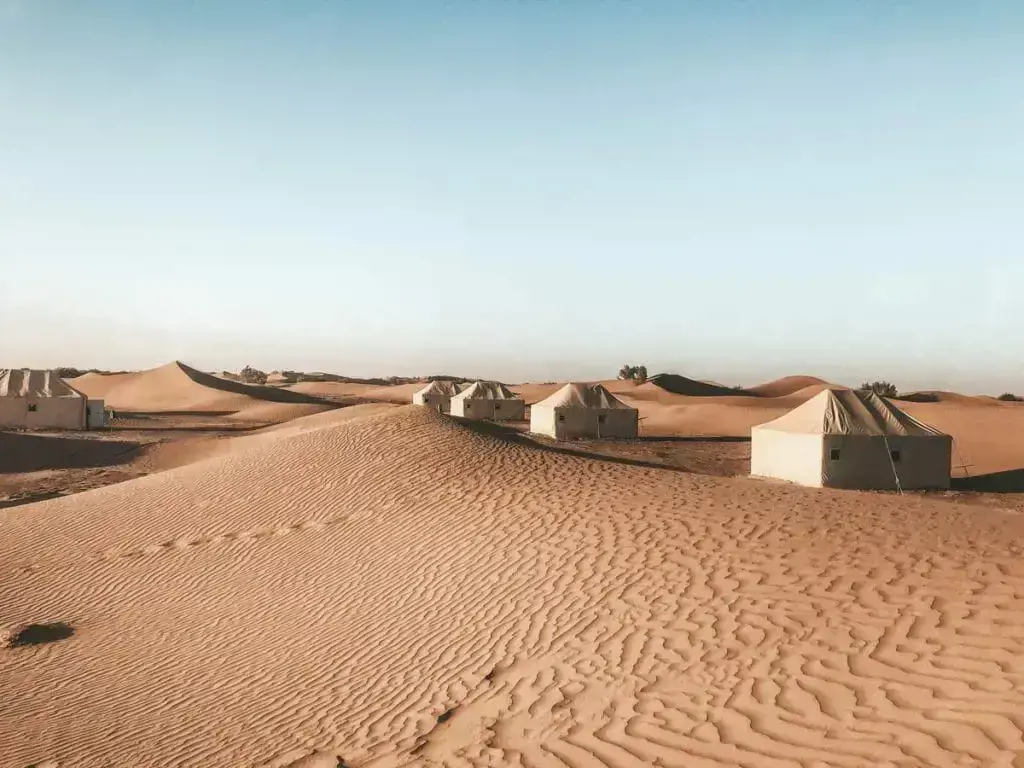
When preparing for a trip to the desert, it is important to prioritize safety and be prepared for any unexpected situations that may arise. This includes packing precautionary items such as first aid kits and emergency supplies. While each person's needs may vary depending on the specific desert environment, there are several essential items that should be included in a desert packing list to ensure a safe and enjoyable experience.
First Aid Kit:
A well-stocked first aid kit is a must-have item for any desert adventure. It should include basic medical supplies such as adhesive bandages, gauze pads, medical tape, antiseptic wipes, tweezers, and scissors. Additionally, it is advisable to include any necessary prescription medications, insect repellent, and sunscreen to protect against the harsh desert sun and potential bug bites.
Water and Hydration:
Staying hydrated is crucial in the desert, as the arid climate can lead to dehydration and heat exhaustion. It is recommended to carry a sufficient amount of water for the duration of your trip, with an additional backup supply in case of emergencies. Electrolyte packets or tablets can also be beneficial to replenish lost minerals and salts due to sweating.
Navigational Tools:
Deserts can be vast and easy to get lost in if you are not familiar with the area. It is essential to carry a detailed map, compass, or GPS device to navigate your way and prevent any chances of getting lost. It is also helpful to bring a signaling device such as a whistle or a mirror to attract attention in case of emergencies.
Survival Gear:
In the event of an unforeseen circumstance, having survival gear can be a lifesaver. Essential items to pack include a fire starter, waterproof matches, a multi-tool or knife, a flashlight with extra batteries, a space blanket, and emergency shelter such as a lightweight tarp or bivy sack.
Communication Devices:
Maintaining communication with the outside world is crucial in case of emergencies. It is wise to carry a charged cell phone or a satellite phone if you are in an area with no cell reception. Furthermore, consider bringing a portable charger to ensure your devices stay powered.
Personal Protection:
Protecting yourself from the harsh desert elements is essential for safety and well-being. In addition to sunscreen and insect repellent, pack a wide-brimmed hat, lightweight long-sleeve shirts, and pants to shield yourself from the sun's rays and potential thorny vegetation. Sunglasses and a bandana or scarf can also be useful to protect against wind-blown sand.
Emergency Food:
Having an emergency supply of food can be crucial if you get stranded or lost in the desert. Pack non-perishable items such as energy bars, nuts, dried fruit, and canned goods that can be easily consumed without the need for cooking or refrigeration.
While these are the essential items to include in a desert packing list, it is important to research the specific desert region you are visiting and tailor your supplies accordingly. Consider consulting with experienced desert travelers or local authorities for additional recommendations based on the location's unique characteristics and potential risks.
In conclusion, when packing for a desert adventure, it is vital to prioritize safety and be prepared for any situation. Including a well-stocked first aid kit, ample water, navigational tools, survival gear, communication devices, personal protection, and emergency food will help ensure a safe and enjoyable experience in the desert. Remember to check your supplies before each trip and replenish any expired or used items. Stay informed of local weather conditions and follow best practices for desert travel to make the most of your desert excursion.
Essential Items to Pack for a Successful Softball Tournament
You may want to see also
Frequently asked questions
When packing for a trip to the Sahara Desert, it is important to choose clothing that will protect you from the intense heat. Loose and breathable clothing made from lightweight and natural fabrics like linen or cotton is recommended. Long-sleeved shirts and long pants will provide protection from the sun and help to prevent sunburn. Additionally, it is important to pack a wide-brimmed hat, sunglasses, and a lightweight scarf or bandana to protect your head and neck from the sun.
When it comes to footwear for the Sahara Desert, it is important to choose a pair of shoes that are comfortable and can withstand rugged terrain. Closed-toe shoes, such as hiking boots or sturdy sandals, are recommended to protect your feet from the hot sand and sharp rocks. It is also a good idea to bring a pair of lightweight and breathable socks to wear with your shoes to prevent blisters and keep your feet dry.
Besides clothing and footwear, there are several essential items that you should pack for a trip to the Sahara Desert. These include a good sunscreen with a high SPF, a reusable water bottle to stay hydrated, a first aid kit with basic medical supplies, insect repellent, a map or GPS device, and a headlamp or flashlight for navigating in the dark. It is also important to pack enough food and snacks to sustain you during your time in the desert.
While it is important to pack the necessary items for a trip to the Sahara Desert, there are also certain things that you should avoid bringing. Heavy luggage or large suitcases can be difficult to transport through the sandy terrain, so it is best to bring a lightweight and compact backpack or duffle bag instead. Additionally, it is not recommended to bring expensive or delicate electronics, as the desert environment can be harsh and damaging to these items.







